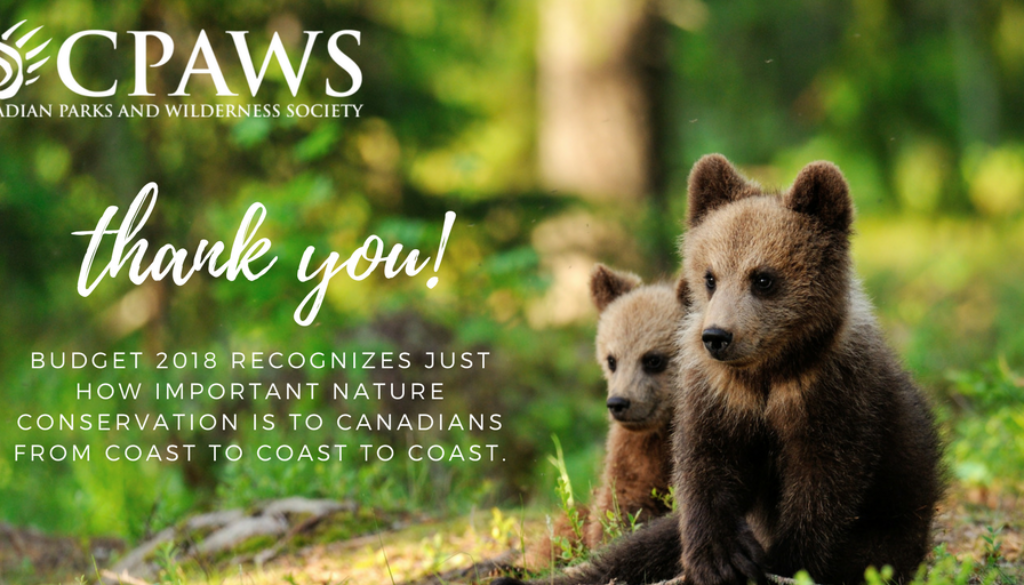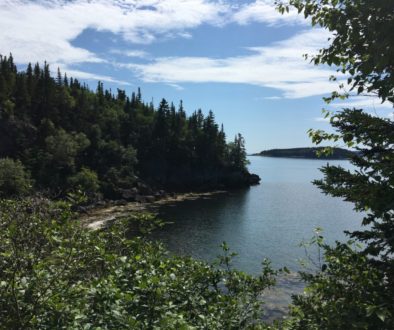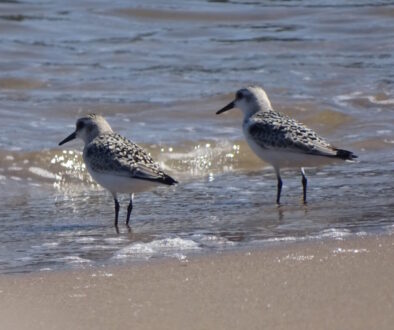CPAWS celebrates “historic investment” in nature conservation in Federal Budget 2018
CPAWS applauds today’s announcement of $1.3 billion dollars over 5 years to protect Canada’s land, ocean, and wildlife. This unprecedented investment will enable Canada to achieve its commitment to protect at least 17% of our land and freshwater by 2020. To date, Canada has protected 10.6% of our landscape. In New Brunswick, 4.6 % is currently protected.
“Today’s historic federal investment in protecting wildlands and wildlife could be a game-changer for nature conservation across Canada, including in New Brunswick,” says Roberta Clowater, Executive Director of CPAWS New Brunswick Chapter. “Budget 2018 recognizes the scale of the biodiversity crisis we face, the need to move quickly to deliver on our promises, and the need to support efforts by all levels of government, civil society, and other partners to protect our treasured natural heritage.”
For the first time, the federal budget not only allocates funding for federal action on nature conservation, but also includes significant support for provinces, territories, and Indigenous governments’ work to establish more protected areas. This cost-shared model is similar to the approach used to deliver other shared priorities in Canada, such as infrastructure, climate change mitigation, and health care.
Highlights of federal Budget 2018 conservation investments include:
- $500 million over five years for a new $1 Billion “Nature Fund” to support conservation partnerships and which will leverage funding from other government and non-governmental sources;
- $800 million over five years to support:
- New federal protected areas
- Increased capacity for national park management
- Increased capacity to protect species at risk
- Funding to establish a coordinated network of conservation areas working with provincial, territorial and Indigenous partners.
“While there are few details available at this early stage, we are hopeful this is an opportunity for the New Brunswick government to secure much needed funding to support the creation of new protected areas in our province, such as the Restigouche Wilderness, and important coastal habitats,” says Roberta Clowater, Executive Director of CPAWS NB Chapter. “With this additional support we hope to see the provincial government establish an action plan, and start to take action to protect these and other crucial natural areas.”
“We are particularly pleased to see the budget acknowledge the leadership of Indigenous peoples in conservation across Canada, and we hope this funding will help advance their work in New Brunswick, which could also contribute to reconciliation between Indigenous and non-Indigenous peoples,” says Clowater.
“We thank the federal government for listening to the recommendations made by CPAWS and our environmental partners in the Green Budget Coalition,” says Alison Woodley, CPAWS’ National Conservation Director, “and we deeply appreciate the efforts of many thousands of Canadians who wrote to the Finance Minister, and of the 116 parliamentarians who signed an open letter supporting our recommendations. Today’s investment confirms how much Canadians care about this issue and shows that raising our collective voice truly works!”
“Investing in protected areas will conserve Canada’s wildlife, water, and wilderness, provide more protected spaces for healthy outdoor activities, and create jobs in communities across the country by growing sustainable nature and culture-based tourism economies,” says Woodley. “This is an investment in the future of our country, which will deliver huge returns.”
-30 –
For interviews:
Roberta Clowater: rclowater@cpaws.org; 506-452-9902
BACKGROUND
The UN Convention on Biological Diversity
In 2010, Canada and other signatories to the UN Convention on Biological Diversity endorsed a strategic plan to reverse a global biodiversity crisis, including a commitment to protect at least 17% of land and inland waters and 10% of ocean areas by 2020 and to improve the quality of protected area networks. The Biodiversity Convention (known as the CBD) was signed in 1992 alongside the UN Convention on Climate Change, recognizing the need to jointly tackle these two critical environmental challenges. Last year the federal government invested in a Pan-Canadian Climate Plan. This year’s investment will support a parallel pan-Canadian effort to protect biodiversity.
The Federal Government’s Recent Efforts towards Achieving Our Commitment
In March 2017, a unanimous report by the House of Commons Standing Committee on Environment and Sustainable Development made a suite of recommendations for action on protected areas.[1] In February 2017, federal, provincial, and territorial governments launched the “Pathway to Canada Target One” process, working with Indigenous peoples, civil society, and private interests to jointly deliver on Canada’s land and freshwater protection target.[2] CPAWS staff were appointed to a Ministerial “National Advisory Panel” to advise on this work. The Panel’s report is expected to be released soon.
Fisheries and Oceans Canada has been leading federal government efforts towards protecting at least 10% of the ocean by 2020, and has made significant progress over the past two years, including the establishment of the Hecate Strait and Queen Charlotte Sound glass sponge reef MPA in BC, and St Anns Bank MPA in Nova Scotia.
[1] http://www.ourcommons.ca/DocumentViewer/en/42-1/ENVI/report-5/
[2] http://www.conservation2020canada.ca/home



